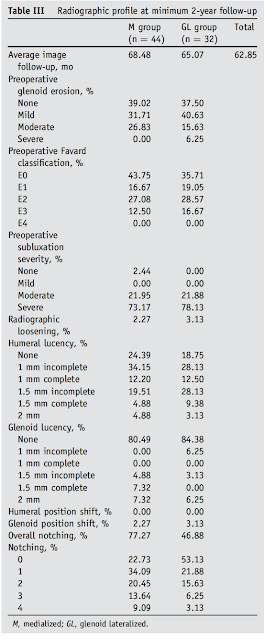These authors compared their long-term outcomes, complications, and reoperation rates for primary reverse total shoulder arthroplasty (RTSA) performed at a single institution using 2 implant designs: a Grammont-style medialized prosthesis combining a medialized glenoid with a 155 degree inlay polyethylene humeral component (medialized [M] group)
and a Frankle-style combining a lateralized glenoid with a 135 degree inlay polyethylene humeral component (glenoid-lateralized [GL] group).
Patients were followed up until death, until revision surgery, or for a minimum of 10 years.
Notching rates were significantly higher in the M group (77% in M group vs. 47% in GL group, P . .013); differences in severe notching (grade 3 or 4) were clinically relevant but did not reach statistical significance (23% in M group vs. 9% in GL group.
Reoperation was required in 6 shoulders (10-year cumulative incidence of 3 [5%] in M group vs. 3 [8%] in GL group) for a total of 16 complications (10-year cumulative incidence of 8 [14%] in M group vs. 8 [20%] in GL group). The reasons for reoperation were dislocation (2), polyethylene disassociation (1), glenosphere disassociation (1), infection (1), and acromial stress fracture (1).
Other complications included intraoperative or postoperative periprosthetic fractures (6), acromial stress fractures (2), brachial plexopathy (1), and a distal clavicle insufficiency fracture (1), for a total of 16 complications for both groups (10-year cumulative incidence of 8 [14%] in M group vs. 8 [20%] in GL group.
It is interesting to note the different times of appearance of reoperations and complications between the two types of implants, as shown below.
Aside from better active elevation in the M group, no substantial differences were found between the 2 implant styles in terms of clinical outcomes, complications, and reoperations.
Comment: This is a valuable paper showing the longer term outcomes achieved with surgery performed a decade ago. As pointe out by the authors, these surgeries were performed before many of the important elements of surgical technique had been established.
==
To see a YouTube of our technique for a reverse total shoulder arthroplasty, click on this link.
=====
To see our new series of youtube videos on important shoulder surgeries and how they are done, click here.
Use the "Search" box to the right to find other topics of interest to you.
You may be interested in some of our most visited web pages arthritis, total shoulder, ream and run, reverse total shoulder, CTA arthroplasty, and rotator cuff surgery as well as the 'ream and run essentials'




